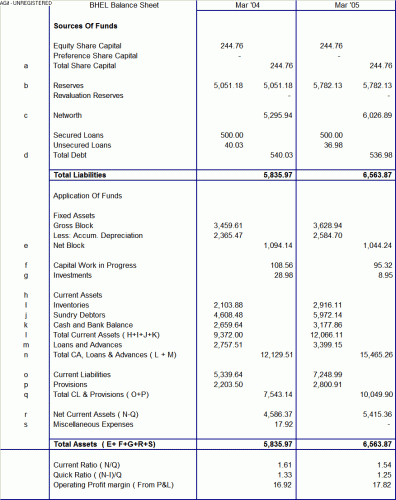Balance Sheet आर्थीक ताळेबंद
Balance Sheet is a snapshot of a business at A POINT of Time. At a particular date, usually financial year-end date, all the assets and liabilities are counted and presented as a statement. This gives the overall picture of a company. Why read balance sheet? What Do I care about that company? If you are an investor in that company then yes you HAVE to care otherwise NO.
Balance sheet is divided in 2 parts.
1. Sources of Funds - this includes share capital, short and long term debts, creditors and Profits retained by the business over the years are also a source of funds. These are included under the head "Reserves and Surplus".
2. Application of funds. How you have applied the fund you accumulated. Examples are assets, investments, debtors etc.
In short Capital+ Liabilities = Total Assets.
"Balance Sheet is always balanced" - That 19s why it is called as balance sheet. मी ICWA करतान मला एक मित्र होता, त्याचे background BE चे होते. accounts त्याला निट येत न्हवते. त्याचे accounts चे problem कधीही सुटत नसत balance sheet tally होने म्हनजे it is balanced. but he knows Balance Sheet is always balanced म तो सर्वात शेवटी assets & Lib. मधला diff काढायचा व ती figure तो कमी असलेल्या part मध्ये either asset or lib. मध्य add करायचा अ balance Sheet, balance करायाचा.
Why read Balance Sheet? - So many reasons like find out the liquidity ratios, growth of the company etc.
BHEL Balance sheet explained.
* Equity - The amount contributed by shareholders. (Remember its not that market value of shares but face value of shares)
*Reserves - Profits from the P & L account carried forward to B/s. it is called as retained earnings.
* Total Debt - Loans taken by BHEL.
* Gross Block - Total value of fixed assets when acquired.
* Dep- (explained earlier) - reduction in value
* Net assets Gross block - Dep
* Capital work in progress: When the company grows and expands its operations, there are often unfinished plants, buildings under construction and so on. These are clubbed under capital work-in-progress
*Debtors - These are the people who owe money to the company. (Part of Current Assets)
* Loans and Adv. - Advance give by company to other (like Prepaid exp.)
* Current Liabilities- The Company owes to these guys. They may be suppliers of the goods, service providers etc.
Based on above we need to calculate key financial ratio. There are many ratios but for scope of this article I will cover few.
Operating profit margin (OPM) this ratio is indicative of the operating profit generated per rupee of sales in percentage terms.
OP Margin = operating profit / by sales.
Net profit margin tells us how much net profit has been earned on every rupee of sales generated.
Net Profit margin = Net profit / by sales.
Current Ratio - Simply put this ratio tells us the balance between current availability vs. requirement. It 19s a liquidity ratio. So bigger the ratio better for us.
Current Ratio = Current Assets / Current Libilities.
Acid Test or Quick Ratio - Some cautious investors like to calculate quick ratio. They substract Inventories from the current assets and divide it by Current libilities.
Acid Test Ratio = ( Current Assets 13 Inventory)/ Current Libilities.
There are so many ratios to choose from like interest cover ratio, Capital gearing ratio etc.
I am writting this artical in english because I could not find proper words for terms like Acid test Ratio etc. तसदी बद्दल क्षमस्व.
